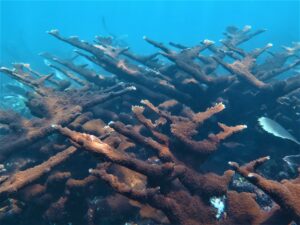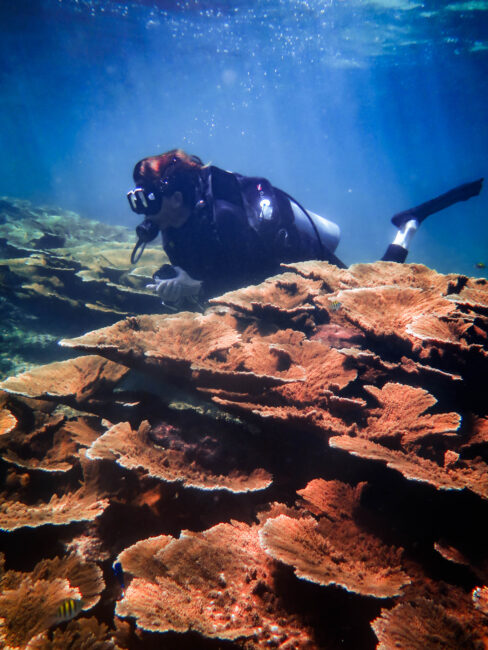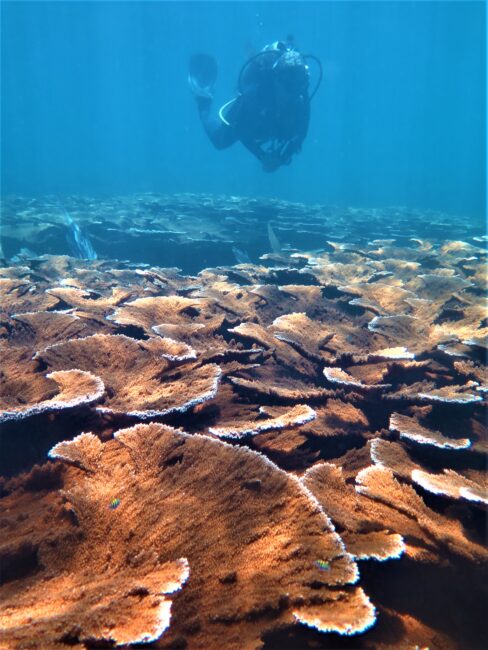 If you would have gone diving in the Caribbean forty years ago, you would have had to try very hard not to see a branching coral known as elkhorn, or Acropora palmata. One of the region’s most abundant species, its colonies formed jungles on the crests of nearly all Caribbean reefs. From the side, it is visually striking, sculptural, and regal. Its branches cross in a classic V shape that reflects in a sort of fractal form through the coral forest. Ecologically, elkhorn corals form a living cap on top of the reefs, one that adds bulk to the stony platform, repairs itself after storms, and provides shelter for countless other creatures.
If you would have gone diving in the Caribbean forty years ago, you would have had to try very hard not to see a branching coral known as elkhorn, or Acropora palmata. One of the region’s most abundant species, its colonies formed jungles on the crests of nearly all Caribbean reefs. From the side, it is visually striking, sculptural, and regal. Its branches cross in a classic V shape that reflects in a sort of fractal form through the coral forest. Ecologically, elkhorn corals form a living cap on top of the reefs, one that adds bulk to the stony platform, repairs itself after storms, and provides shelter for countless other creatures.
Today, you would have to try very hard to see this once iconic animal. The giant groves of elkhorn have fallen. The reef crests are now almost bare. Elkhorn are on the brink of extinction.
About two years ago, I was invited to Tela, Honduras, and was astonished to find that perhaps the last surviving grove of elkhorn coral thrives there. I don’t know how big this grove of Acropora palmata is, but you can spend a whole dive kicking across its breadth and width and not see all the colonies. You can hunker down and look through the jungle from the side and see the fractal Vs form before your eyes. When I saw this part of Tela’s reef for the first time, what ran through my mind was, “It’s like swimming with a herd of white rhinos.”

From the first time I saw it, I knew that this grove of elkhorns was special, and I knew that it needed scientific attention. But it is only one of the many things in Tela that deserve scientific attention. The urgency to prioritize this coral didn’t strike until this month That’s when survey results from Florida found that almost none of the elkhorn survived the record heatwave last summer.
Worse. This is an El Niño year, which coupled with the climate crisis portends another hot year in the ocean. Australia is already broiling. It could be the worst bleaching they’ve experienced. And the heat will come to the Caribbean this summer.
Because of their very extistence, Tela’s elkhorns are special. Even during last summer’s record heat, they bleached a bit and recovered. But it is irresponsible–at best–to ignore the reality of this year’s conditions. Do we sit around and watch the inevitable heatwave kill what could be the last grove of healthy elkhorn in the world, and wish we’d had the foresight to preserve this rare population? (If you know of another stand of healthy elkhorn, please let me know.)
So, what can we do? I think the question is better said: what must we do? We must preserve, at a minimum, the genetics of these resilient corals. We need a genetic bank to secure what’s truly priceless information.
Here’s what it looks like: Genetic banks are basically very secure and robust tanks, where we can hold as many fragments of elkhorn as possible to sit out the heatwave. If we had the money and the time, we could genotype the animals first, to make sure we were collecting the full range of genetic diversity, but it’s unlikely we’ll be able to do that. So, we’ll collect fragments from throughout the stand, and do the genetics afterward.
We need duplicate systems in case one fails. Triplicate would be better. We are lucky to be working with our local Honduran partner Tela Marine, who have identified space to house these systems and who already have expertise in coral husbandry. It would be beneficial to bring in experts from Florida who have specific experience with elkhorn coral to share what they’ve learned about this species.
I’ve been in touch with granting agencies, but they don’t have the correct programs in place to respond to this kind of urgent need. I was told, if something happens, then we might be able to respond, but not preemptively. That means we have to do it ourselves.
Earlier this year, with amazing colleagues, I helped establish the 501(c)3 non-profit, Amigos de los Corales de Tela, which we now just call Tela Coral, to support education, science, and storytelling in Tela. Due to the urgency of the heatwave this summer, we are pivoting our efforts to build a gene bank for elkhorn, and later, other endangered species that thrive in Tela.
We need $46,000. This would fund the construction of duplicate gene banks, a Honduran aquarist’s salary to maintain the banks, the field work to collect the fragments, and the genetic analysis. I’m happy to share the budget if you would like to identify a part of the project to support.
I don’t know if we will be able to raise the money before the heat wave comes this August, but we must try. If you can contribute, your generosity will help preserve one of the great and foundational species on our planet; one whose struggle has received far too little attention and which still has so much to teach us. Thank you for anything you can contribute. Here’s a link to donate. Your contributions are tax-deductible in the U.S.
